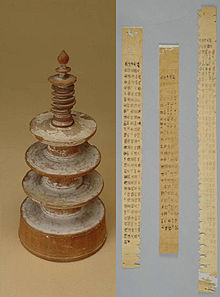Hyakumantō Darani

The Hyakumantō Darani ( 百万 塔 陀羅尼 ) or "A Million Pagodas and Dharani Prayers" are a famous Buddhist block printing company and the oldest material evidence of letterpress printing in Japan.
These prints were made by order of Shōtoku-Tennō 764 - 770 with copper or wood blocks. A Dharani is an Indian spell similar to a mantra , but much longer. The present Vimala nirbhasa Sūtra was translated into Chinese by the Tocharian Buddhist missionary Mitraśanta 704 with the title Wugou jingguang tuoloni jing 無垢 浄光 陀羅尼. In Japan it was read in Sino-Japanese Mukujōkōdarani.
The allegedly 1 million printed paper rolls in small wooden pagodas became much better known as Hyakumantō Darani. They were distributed to 10 Japanese monasteries. In Hōryū-ji Temple in Nara for about 40,000 remain, many also came abroad.
In Germany there is one copy in Berlin (SB Preussischer Kulturbes), two copies in Munich (German Museum, Bayer. Staatsbibl.) And one in Mainz (Gutenberg Museum).
Printing was completed around 770 and cost such a large amount of money that printing technology in Japan was limited to monasteries and the production and distribution of books largely to handwritten copies until the end of the 16th century.
A print of the same text from the first half of the 8th century was found in a pagoda at Bulguksa Temple in Gyeongju , Korea, in 1966. A facsimile is on display at the Museum of Korean Culture in Incheon .
Web links
- Robert G. Sewell: The First Printed Text in the World, Standing Tall and Isolated in Eighth-century Japan: Hyakumanto Darani. In: The Journal of the Rutgers University Libraries. 60, 2003, doi : 10.14713 / jrul.v60i1.3 .
- Ex. D. Schøyen Collection (English)
- Digital Exhibition of National Diet Library (Japanese)
Individual evidence
- ^ Peter Kornicki: The Book in Japan. A Cultural History from the Beginnings to the Nineteenth Century. Brill, Leiden 1998, ISBN 90-04-10195-0 . P. 115
- ↑ Taishō Shinshū Daizōkyō No. 1024
- ↑ A Dufey: Schrift u. Printing in East Asia. In: The book in the Orient. Wiesbaden, L. Reichert, 1982. Exhibit 241, beschr. v. W. Schamoni
- ↑ Small dictionary d. Japanology. Edited by Bruno Lewin. Wiesbaden 1968. p. 63
- ^ Museum of Korean Culture. WP engl.